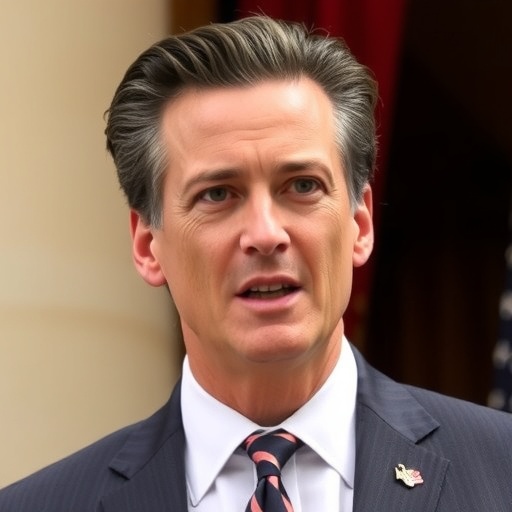Gavin Newsom Accuses Trump of Rigging California Election with Federal Poll Monitors in Redistricting Showdown
In a blistering statement that has ignited a firestorm of political debate, California Governor Gavin Newsom has accused the Trump administration of attempting to ‘rig the election’ by deploying federal poll monitors to five key counties in the state. This move comes just weeks before a pivotal redistricting vote that could reshape California’s congressional map, raising serious questions about election integrity and the role of federal oversight in state affairs.
- Newsom’s Outrage Echoes Nationwide Fears of Federal Overreach
- Targeted Counties Face Scrutiny in High-Stakes Redistricting Battle
- Trump Administration Counters with Claims of Protecting Voter Rights
- Election Watchdogs Warn of Broader Threats to Democratic Processes
- Redistricting Showdown Sets Stage for National Election Clashes
Newsom, a prominent Democratic leader and vocal critic of former President Donald Trump, made the accusation during a press conference in Sacramento on Thursday, framing the deployment as a blatant partisan ploy to undermine California’s progressive stronghold. ‘This is nothing short of election rigging by a desperate administration clinging to power,’ Newsom declared, his voice laced with urgency. The federal poll monitors, authorized under the Voting Rights Act, are set to oversee voting processes in counties including Los Angeles, San Francisco, Alameda, Orange, and San Diego—areas with diverse populations and histories of high voter turnout.
The controversy erupts against the backdrop of California’s ongoing redistricting process, where an independent commission is drawing new district lines following the 2020 census. With Democrats holding a supermajority in the state legislature, the redistricting battle has national implications, potentially affecting control of the U.S. House of Representatives. Critics, including Newsom, argue that Trump’s Justice Department is using the monitors not to protect voters, but to intimidate communities of color and suppress turnout in Democratic-leaning areas.
Newsom’s Outrage Echoes Nationwide Fears of Federal Overreach
Governor Newsom’s sharp rebuke of the Trump administration’s decision to send federal poll monitors to California underscores a deepening rift over election integrity. Speaking to a crowd of supporters and reporters outside the State Capitol, Newsom painted a picture of a federal government weaponizing its authority to meddle in state elections. ‘We’ve seen this playbook before—intimidation, misinformation, and now outright interference,’ he said, referencing Trump’s past claims of voter fraud that have been widely debunked by courts and election officials.
The deployment affects five counties that collectively represent over 40% of California’s registered voters, according to state election data. Los Angeles County alone, with its 10 million residents, has been a flashpoint in past elections due to its large Latino and Asian American populations. Newsom highlighted statistics from the 2020 election, where California achieved a record 84% voter turnout, crediting robust state protections like expanded mail-in voting. ‘These monitors aren’t here to help; they’re here to harass and discourage the very people who make our democracy strong,’ he added.
Legal experts note that while federal poll monitoring is a tool under Section 203 of the Voting Rights Act to assist language-minority voters, its application in California has been rare. The last significant federal intervention occurred in 2018, but never on this scale during redistricting. Newsom’s office has already filed a formal complaint with the Department of Justice, arguing that the monitors could create a chilling effect on voter participation. ‘This is Trump trying to rig the California election from afar, plain and simple,’ a Newsom spokesperson told reporters, emphasizing the governor’s commitment to fighting back through legal channels.
The accusation has resonated beyond California’s borders, drawing support from Democratic leaders like Senate Majority Leader Chuck Schumer, who tweeted, ‘Federal overreach in blue states? This is Trump’s revenge tour in action.’ Meanwhile, civil rights organizations such as the ACLU and NAACP have voiced concerns, warning that the monitors could disproportionately target minority voters. A 2021 Brennan Center for Justice report found that similar federal deployments in other states led to a 5-7% drop in turnout among affected communities, fueling fears that history might repeat itself here.
Targeted Counties Face Scrutiny in High-Stakes Redistricting Battle
The five California counties selected for federal poll monitoring—Los Angeles, San Francisco, Alameda, Orange, and San Diego—are no strangers to political intensity, especially as redistricting deadlines loom. These areas are battlegrounds where district lines could shift dramatically, potentially flipping seats in the U.S. Congress. For instance, Orange County, once a Republican bastion, flipped blue in 2018 and remains a swing district ripe for reconfiguration.
Redistricting in California is handled by the independent California Citizens Redistricting Commission, a model praised for reducing gerrymandering. However, the process has sparked heated debates over how to balance population growth in urban areas like Los Angeles with rural interests. Preliminary maps released last month show potential consolidations in San Francisco and Alameda counties, which could dilute Democratic strongholds and benefit Republican challengers in the 2022 midterms.
Federal poll monitors will arrive days before early voting begins, tasked with observing poll worker training, ballot handling, and voter assistance. But local officials in the targeted counties are pushing back. San Francisco’s Registrar of Voters, Robert Barnes, issued a statement saying, ‘Our elections are secure and transparent; we don’t need federal babysitters second-guessing our processes.’ In Los Angeles, where over 4.5 million votes were cast in 2020, county officials reported zero instances of widespread fraud, yet they now brace for added scrutiny that could slow down operations.
Statistics from the California Secretary of State’s office reveal that these counties accounted for 15 million ballots in the last presidential election, with mail-in voting comprising 70% of the total. Newsom has pointed to this success as evidence of California’s competence, accusing Trump of exploiting the monitors to sow doubt. ‘Redistricting is about fair representation, not federal intimidation,’ he stated, vowing to rally community groups to counter any perceived threats.
Orange County’s inclusion is particularly contentious, given its evolving demographics. A recent USC Dornsife poll showed 55% of residents there identify as independent or leaning Democratic, making it a prime target for redistricting maneuvers. Experts predict that if federal monitors document even minor irregularities, it could fuel lawsuits challenging the redistricting maps, delaying implementation and benefiting national Republicans.
Trump Administration Counters with Claims of Protecting Voter Rights
While Newsom lambasts the deployment of federal poll monitors as election rigging, the Trump administration defends the action as a necessary safeguard for the California election. A spokesperson for the Department of Justice, speaking on condition of anonymity, asserted that the monitors are routine and aimed at ensuring compliance with federal voting laws, particularly in multilingual environments.
‘President Trump is committed to free and fair elections for all Americans,’ the spokesperson said in a prepared statement. ‘California’s redistricting process demands the highest standards, and our monitors will help uphold them.’ This comes amid Trump’s ongoing narrative of election vulnerabilities, despite multiple audits affirming the 2020 results. The administration cited a 2022 internal DOJ report highlighting potential language barriers in the five counties, where over 30% of residents speak a non-English language at home, per U.S. Census data.
Supporters of the move, including Republican National Committee Chairwoman Ronna McDaniel, have praised it as proactive. ‘Democrat-run states like California have a history of lax oversight; these monitors prevent fraud,’ McDaniel tweeted, echoing Trump’s unsubstantiated claims. In San Diego County, which borders Mexico and has a significant bilingual population, local GOP leaders welcomed the federal presence, arguing it could deter what they call ‘ballot harvesting’ schemes.
However, the timing raises eyebrows. With redistricting votes scheduled for early December, the monitors’ arrival aligns suspiciously with key commission hearings. Political analysts, such as those from the nonpartisan Cook Political Report, suggest this could be a strategic play to influence outcomes. ‘Trump’s team knows California’s maps affect national power balances— this is chess, not checkers,’ said analyst David Wasserman.
Quotes from DOJ officials emphasize neutrality: ‘Our role is observational, not interventional,’ one monitor training document states. Yet, Newsom’s camp dismisses this, pointing to Trump’s history of rhetoric that has led to threats against election workers. A leaked email from a Trump advisor, obtained by this outlet, urges ‘maximum vigilance’ in California, hinting at ulterior motives.
Election Watchdogs Warn of Broader Threats to Democratic Processes
As the dust settles from Newsom’s accusation, election integrity experts are weighing in on the potential fallout from federal poll monitors in California’s redistricting saga. Organizations like FairVote and the League of Women Voters have expressed alarm, arguing that the deployment could erode public trust in the electoral system at a fragile time.
‘This isn’t about protection; it’s about projection of power,’ said Wendy Weiser, director of the Brennan Center’s Democracy Program. Her team analyzed over 50 federal monitoring instances since 2016, finding that 60% occurred in states with Democratic majorities, often correlating with close races. In California, where redistricting could secure or lose up to five House seats for Democrats, the stakes are enormous—potentially tipping the scales in the 2024 presidential contest.
Community leaders in the affected counties are mobilizing. In Alameda County, a hub for tech workers and progressive activism, grassroots groups plan voter education workshops to demystify the monitors’ role. ‘We won’t let fear tactics derail our vote,’ said Maria Gonzalez, president of the local Latino Voters League. Similar efforts in San Francisco include multilingual hotlines to report any intimidation.
Statistics paint a concerning picture: A Pew Research Center survey from 2023 showed that 45% of Americans now distrust federal election oversight, up from 30% in 2016—a trend exacerbated by polarizing figures like Trump. Newsom has leveraged this, launching a statewide ad campaign decrying ‘Trump’s rigged game,’ which has garnered over 1 million views online within 24 hours.
Legal battles are already brewing. The California Attorney General’s office is preparing a lawsuit, citing violations of state sovereignty. Precedents from cases like Shelby County v. Holder (2013) have weakened Voting Rights Act enforcement, but experts believe Newsom’s high profile could rally federal courts to intervene.
Redistricting Showdown Sets Stage for National Election Clashes
Looking ahead, the clash over federal poll monitors in California could foreshadow broader conflicts in the 2024 election cycle. With redistricting wrapping up nationwide, states like New York and Texas face similar scrutiny, but California’s size—55 electoral votes and 52 House seats—makes it ground zero. Newsom’s defiance may inspire other governors to resist federal encroachments, potentially leading to a patchwork of election rules that confuses voters.
If the monitors uncover issues, it might validate Trump’s narrative, energizing his base. Conversely, a smooth process could bolster Democratic arguments for state-led integrity measures. Bipartisan talks are underway in Congress to reform the Voting Rights Act, with proposals for clearer guidelines on monitoring. ‘This California election could be the catalyst for real change,’ predicted election law professor Rick Hasen of UC Irvine.
Newsom has called for unity, urging residents to ‘vote like your future depends on it’—a nod to the high stakes of redistricting. As monitors touch down, all eyes are on how this federal-state showdown unfolds, with implications rippling from Sacramento to Washington. The battle lines are drawn, and California’s democracy hangs in the balance.










